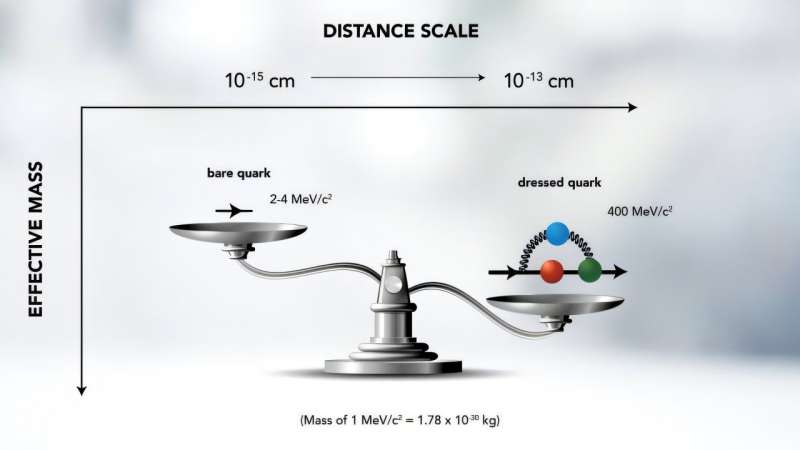Science
Experiments Illuminate the Emergence of Hadron Mass at Jefferson Lab

Understanding the origins of mass in the universe has long been a significant focus in nuclear physics. Recent experiments at the Thomas Jefferson National Accelerator Facility (Jefferson Lab) have shed light on how most of the visible mass in the universe is generated, particularly through the mechanisms behind hadron mass. Researchers are uncovering the complexities of how protons, neutrons, and other hadrons acquire their mass, revealing a deeper understanding of the fundamental forces at play.
The enigma surrounding hadron mass stems from the fact that while protons and neutrons are composed of quarks, which possess minimal mass, the resulting particles are significantly heavier. According to Victor Mokeev, a staff scientist at Jefferson Lab, the Higgs mechanism—a process confirmed by experiments at the CERN Large Hadron Collider—explains that quarks acquire their “bare mass” through interactions with the Higgs field. However, this mechanism accounts for less than 2% of the total mass of protons and neutrons, indicating that the majority of their mass arises from another source.
Recent advancements in understanding this mass-generating process are attributed to the study of the dynamics of Quantum Chromodynamics (QCD). QCD describes how the strong force, which binds quarks together via gluons, contributes to the emergence of hadron mass (EHM) through energy stored in the interactions of these particles. This concept reflects a deeper mechanism where the mass arises not solely from the quarks themselves, but from the complex interactions within the strong force.
Decades of Progress in Understanding Emergent Mass
Over the past decade, physicists at Jefferson Lab have made remarkable strides in elucidating the dominant portion of the universe’s visible mass. By employing a technique known as the continuum Schwinger method (CSM), researchers analyzed nearly 30 years of data collected at Jefferson Lab. This comprehensive effort culminated in a detailed study featured in the journal Symmetry.
“This is more than what you’d see from a single experiment or set of experiments,” noted Daniel Carman, an experimental nuclear physicist at Jefferson Lab. “We still have a lot of work ahead, but this marks a major milestone along the way.” The research underscores the intricate relationship between theoretical models and experimental findings, paving the way for a more complete understanding of hadron mass.
The strong force’s unique characteristic, known as gluon self-interaction, plays a pivotal role in shaping the properties of hadrons. Without this self-interaction, the universe would manifest entirely different physical realities. Mokeev emphasized the importance of gluons in creating the diverse properties of particles and the emergent phenomena of real-world hadrons.
Connecting Experiments to Theoretical Models
The Continuous Electron Beam Accelerator Facility (CEBAF) at Jefferson Lab is pivotal in this research. CEBAF delivers high-intensity electron and photon beams, enabling experiments that probe the structure of protons and their excited states. The facility’s CEBAF Large Acceptance Spectrometer for 12 GeV (CLAS12) is particularly noteworthy due to its upgraded capabilities, allowing it to capture a broad range of particle interactions.
Data collected from CLAS and CLAS12 is instrumental in testing theoretical predictions from CSM. The findings validate the hypothesis that dressed quarks—quarks that interact with clouds of other quarks and gluons—are fundamental to understanding the structure of protons and their excited states. Mokeev remarked on the necessity of collaboration across experimental and theoretical domains to unravel the complexities of hadron mass.
Despite the progress, researchers acknowledge that significant work remains. Earlier experiments conducted during the 6 GeV era of CEBAF explored a momentum range contributing to approximately 30% of hadron mass, while ongoing studies in the current 12 GeV era aim to extend this understanding to around 50%. Future experiments with higher-energy electron beams will further illuminate the distance scales where the majority of hadron mass emerges.
In summary, the ongoing research at Jefferson Lab is advancing the scientific community’s understanding of the mechanisms behind hadron mass, moving closer to mapping out the full range of distances where mass generation occurs. These efforts not only enhance the knowledge of fundamental physics but also deepen our grasp of the universe’s visible mass and its implications.
-

 Health3 months ago
Health3 months agoNeurologist Warns Excessive Use of Supplements Can Harm Brain
-

 Health3 months ago
Health3 months agoFiona Phillips’ Husband Shares Heartfelt Update on Her Alzheimer’s Journey
-

 Science1 month ago
Science1 month agoBrian Cox Addresses Claims of Alien Probe in 3I/ATLAS Discovery
-

 Science1 month ago
Science1 month agoNASA Investigates Unusual Comet 3I/ATLAS; New Findings Emerge
-

 Science4 weeks ago
Science4 weeks agoScientists Examine 3I/ATLAS: Alien Artifact or Cosmic Oddity?
-

 Science4 weeks ago
Science4 weeks agoNASA Investigates Speedy Object 3I/ATLAS, Sparking Speculation
-

 Entertainment4 months ago
Entertainment4 months agoKerry Katona Discusses Future Baby Plans and Brian McFadden’s Wedding
-

 Entertainment4 months ago
Entertainment4 months agoEmmerdale Faces Tension as Dylan and April’s Lives Hang in the Balance
-

 World3 months ago
World3 months agoCole Palmer’s Cryptic Message to Kobbie Mainoo Following Loan Talks
-

 Science4 weeks ago
Science4 weeks agoNASA Scientists Explore Origins of 3I/ATLAS, a Fast-Moving Visitor
-

 Entertainment4 months ago
Entertainment4 months agoLove Island Star Toni Laite’s Mother Expresses Disappointment Over Coupling Decision
-

 Entertainment3 months ago
Entertainment3 months agoMajor Cast Changes at Coronation Street: Exits and Returns in 2025









